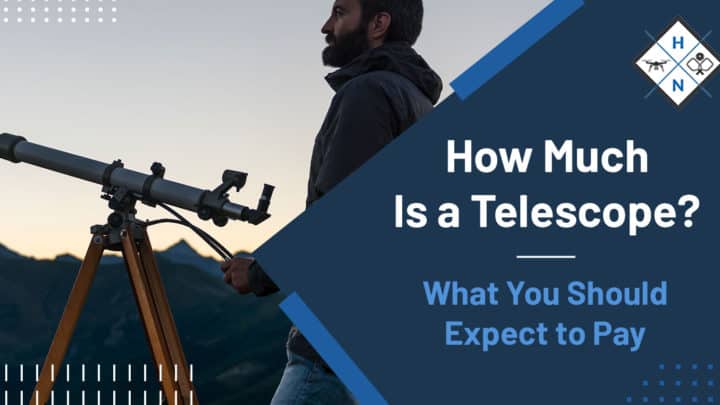Relaxing in your garden or on the balcony is just as convenient as seeing the night sky. However, does it need to be expensive? Due to transportable astronomy telescopes that produce brilliant, clear images of far-off objects, hobbyist astronomy has become a popular pastime for many people.
The price of a decent telescope can range from $200 to $8000. Prices will vary depending on whether you are a beginner or searching for a professional telescope. The purpose and the requirements of a specific user will determine the qualities of a good telescope. The cheapest telescope costs $50.
Amateur telescopes come in various weights, sizes, specs, and features. However, not most of them reflect clear, vivid images of far-off things. These low-end telescopes are typically inexpensive compared to telescopes with large apertures and high magnification.

How Much Is A Good Telescope?
Amateur astronomers commonly use both reflector and refractor telescopes. Mirrors are used to construct reflector telescopes to gather light and focus it on a specific area. The secondary mirror is close to the tube's top, and the lighting flows through it, so it gets there.
As a result, the eyepiece receives the light. The Newtonian Reflector is the mechanism causing this. Another kind is the refractor telescope, which uses convex lenses to focus light at a specific point. The eyepiece, the second lens, receives the light and distributes it to the center of the eye.
There are several types of telescopes; each has a different price range. However, the general price range for most telescopes is from $50 to $600,000. To acquire an excellent telescope for novices or youngsters, experts think you should spend at least $70 to$100.
Dobsonian Telescope
The strongest telescopes for seeing the planets and moon are widely acknowledged to be Dobsonian telescopes. Regarding aperture size, this reflecting telescope provides the best value. Dobsonians are far more affordable to produce because all of their optical components are made of mirrors; therefore, buying a telescope with a large aperture is possible for a fair price.
For a 4-inch portable telescope, the starting price for a Dobsonian telescope is around $100. These telescopes are superb, inexpensive, and simple to operate. The Classic 6-inch Dobsonian is a great option for about $315 if you desire a normal telescope with a bigger aperture. The larger models of this telescope are a little higher; the 8-inch model costs around $450, and the 10-inch model costs about $615.
Beginner Telescope
You do not necessarily need an expensive, high-end telescope starting with astronomy. There are a few causes for this; you will not understand how to utilize it to its maximum capacity if you are a beginner. To prevent being discouraged and ultimately losing interest in the activity, avoid purchasing an expensive telescope at first.
The planet and moons are the easiest celestial objects to find, so it is strongly advised to pick a telescope strong enough to display both. For someone new to stargazing, a decent Dobsonian telescope with an aperture size of 4 to 8 inches is ideal. These telescopes range in price from $100 to $500 and are very simple to use.
Refractor Telescope
In general, refractive telescopes cost a little more than reflecting telescopes. This is because refractors have glass lenses rather than the mirrors found in Newtonian telescopes. Today, entry-level refractor telescopes may be purchased for a very low cost, such as the Celestron 50AZ PowerSeeker, which costs only $60.
Sadly, the materials used to construct these refractors are of poor quality and not worth the cost. The caliber of the glass put at the aperture plays a significant role in choosing a decent refractor. Achromatic refractors typically cost between $50 to $450.
Apochromatic refractors employ a unique kind of glass that is far better at reducing image distortion. Some of them have a total of up to five lenses. As a result, apochromatic refractors can cost anywhere from $800 to thousands of dollars.
Astrophotography Telescope
Astrophotography has a reputation for being an expensive pastime, and that reputation is entirely warranted. Modern instruments and premium optical components are necessary to capture high-quality images of deep-sky objects. The telescope may not be the most expensive piece of equipment.
In actuality, it is the amount that the telescope is fixed to. Astrophotography telescopes range in price from $800 to $1,500 for entry-level versions to $1,500 to $3,000 or even more for high-end models. In the astrophotography field, William Optics APO 51 RedCat is a very well-liked product. Most people start their hobbies with this telescope, which costs around $800.
Telescope Cost
For an astrophotographer, a competent telescope can cost up to $1,500, but for the casual spectator, a nice telescope can run about $400. A telescope's cost rises in direct proportion to its performance potential. The price of each type of telescope can vary depending on various criteria. Below, we will go over a few of the most prevalent ones.
The Aperture
The length of a telescope's lens or main mirror is known as the aperture. It is the telescope area where light beams from celestial objects are collected. Among the most crucial telescope characteristics is the aperture because it greatly impacts how well defined the image is when viewed through the eyepiece. Put, a telescope's price increases with its aperture size.
The Brand
In reality, a small number of Chinese companies produce most of the telescopes on sale. Then, these telescopes are given to a small number of European and American distributors who sell them under various names, labels, and brands. Therefore, it is possible for two telescopes that appear to be a little different but are marketed under several brands to be the same Chinese-made type.
The Focal Length
The distance between light rays in a telescope is known as its focal length. Although the visual field is broader with a short focal length, the examined item will look smaller. Since night sky objects are by definition quite massive, this is very advantageous for astrophotography. On the other hand, a longer focal length offers a limited angle of vision, but the object being examined will look bigger and lighter.
Material Of Production
Since they are composed of flimsy materials like plastic for the tube and aluminum for the tripod, entry-level telescopes are typically cheaper. Owning a precisely calibrated telescope and the frame is essential for getting the most out of the night sky. You will undoubtedly have a bad time using a shaky telescope, and you might decide not to use it as frequently.

Optical Design And Accessories
Each type of telescope employs a unique set of optical elements that control how light is transmitted through the aperture to the lens. Lens-based telescopes often cost more than mirror-based ones. A premium focuser or good ocular lens might be pricey. The attachments' caliber may significantly influence your telescope kit's overall price.
The Shipping Cost
Depending on the telescope you bought, shipping and handling costs might vary greatly, which can significantly increase the final bill. This charge will vary based on the item's size, weight, shipment, and degree of fragility. A beginner's telescope costs nothing to have delivered, but a 12-inch Dobsonian telescope featuring the GoTo feature that is sent home in three different boxes will cost you even more.
Final Thoughts
Returning to the article's title, how much does a decent first telescope cost? It relies on a number of the things we have spoken about and varies on you and your financial situation. Choosing the best telescope depends as much on you as on the tools. When making your decision, your condition and budget should be key factors. Astronomy is a fantastic activity for spending time with loved ones. It can help you and your kids grow closer while advancing their education.
More like this:
Shawn Manaher loves to play with new toys and dive into new hobbies. As a serial entrepreneur, work definitely comes first but there is always room for hobbies.

